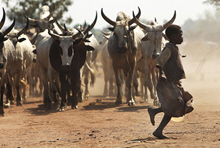
Typical street scene in Santa Ana, El Salvador. (Photo: iStock)
IMF Survey: New Rules For Access to Low-cost Loans
February 1, 2010
- Eligibility criteria set for access to IMF’s concessional loans
- More transparency, greater alignment with global standard practices
- Recent overhaul of low-income country financing now complete
In a bid to target concessional financing to the countries in greatest need, the IMF has reviewed the rules it uses to decide whether member states are eligible for concessional loans.

In new framework, countries are added to list of members that can tap cheap loans under Poverty Reduction and Growth Trust (photo: Spencer Platt/Getty Images)
HELP FOR LOW-INCOME COUNTRIES II
The new framework will determine access to the IMF’s low-cost loans that are part of the Fund’s Poverty Reduction and Growth Trust (PRGT) — a new range of financing and support instruments designed to help alleviate poverty and support growth in the poorest countries.
“The Fund’s concessional loans have helped many low-income countries weather the impact of the global economic crisis, but it is important these resources be preserved for those in most need,” said Jan Kees Martijn, Deputy Chief of the IMF’s Low-Income Country Division.
“This framework is a significant step in modernizing and updating the Fund’s decision-making process on concessional loans. It will introduce greater transparency and consistency into the process of determining which countries can get these loans,” he added.
The new framework completes the Fund’s recent overhaul of its support for low-income countries. In the most significant revamp for this group in two decades, the IMF has boosted lending resources, raised borrowing limits, eliminated interest payments for two years, and is offering new lending instruments with more flexible terms tailored to country circumstances.
New framework for eligibility and graduation
Under the new framework, countries are added to the list of members that can tap cheap loans under the PRGT, if their annual per capita income is below a defined poverty line, and they do not have substantial and sustained access to international financial markets. This poverty line is based on the threshold that helps determine eligibility for support by the International Development Association (IDA), and is formulated in terms of a country’s gross national income (GNI) per capita. For this year, the threshold has been set at $1,135.
The rules determining when a country graduates from PRGT eligibility have also been tightened to avoid premature graduation and to reduce the risk of countries having to fall back onto concessional loans.
A country would no longer have access to PRGT funds if it had a persistently high level of income — exceeding twice the IDA threshold — or if it were deemed able to access international financial markets on a sustained basis.
A second prerequisite for graduation is that the country does not face serious near-term risks of a sharp decline in per capital income, loss of market access, and/or debt vulnerabilities.
International standard practices
The newly streamlined IMF rules are broadly in line with those used by the World Bank Group to determine whether a country is eligible for IDA resources.
“When we were deciding the criteria for graduation, we had to balance the need to protect scarce concessional resources for the poorest members against the danger of premature graduation, which could put at risk a member country’s financial sustainability,” said Martijn.
Under the new framework, 71 low-income countries will be eligible for the Fund’s concessional lending, while Albania, Angola, Azerbaijan, India, Pakistan, and Sri Lanka, will graduate from access to concessional IMF financing in April 2010.


